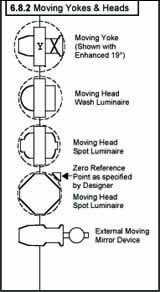 |
 |
 |
|
|
October 28 Deadline
For Lighting Graphics Comments The Lighting Commission members announce with great pleasure the latest draft/canvass of the USITT RP-2: Recommended Practice for Theatrical Lighting Design Graphics (revision 4). We hope that this document will be adopted as the new recommended practice for lighting graphics. As many are aware, the current graphics standard has needed revising for many years because much new gear has been introduced to the profession. The Lighting Commission has worked for the last five years to update this Recommended Practice. Those new to this project should note the actual graphics portion of the document is greatly expanded. Most notably, there are provisions for new conventional and non-conventional luminaires, moving lights, and a number of accessories such as gobo rotators that didn't exist when the earlier standard was created. Many issues related to angle specifications are addressed while the accessories and cyc/striplight portions of the document reflect a much wider range of equipment. Those familiar with this project and who may have responded to last year's canvass may note the numerous other changes for lighting graphics that reflect common practices currently in use. Obviously, because of personal preferences, there will never be complete agreement to all of the conventions outlined in the new document. However, what is represented within RP-2 (version 4) forms a solid foundation for those graphic standards widely practiced today for creating light plots and sections. Several key updates to this version were added as a result of the third canvass. They include: additional luminaires and accessory symbols (mirror accessories, revisions in ballasted fixtures, and sections relating to fluorescent and LED luminaries); a line weight specification; a more developed section on booms; and more specifics on numbering conventions. The more popular practice of using circle containers for inserting channel information was adopted, and channel/dimmer/circuit designations within each of the primary control configurations (dimmer per circuit, direct patch to dimmers, and systems reflecting both a direct and soft-patch set-up) are illustrated. The manner of designating accessories such as rotators and gobos was modified, and the Recommended Practice goes back to the earlier manner of expressing bottle direction for PAR fixtures. Finally, as a result of comments from a few participants who wanted to address 3-D drafting practices, the committee chose, after much debate, to only address the standards from a 2-dimensional perspective. The rationale used is that light plots and sections are used as communication documents that are expressed through 2-dimensional drafting practices. The need for 3-dimensional graphics relates more to the visualization of a lighting design. Additionally, the Recommended Practice uses generic symbols rather than the more specific 3-dimensional symbol draftings used in visualization purposes which often vary considerably from one manufacturer to another for a given type of luminaire. A canvass or draft document is a proposal distributed widely to members of the profession for comment and input. What is posted through RP-2 (version 4) here and on the USITT web site is a draft of what committee members hope will be adopted as the new Recommended Practice. However, before officially adopting the draft, there is an opportunity for public comment and input. The committee attempts to get public comment by distributing the draft through two channels: first, some individuals are approached directly, and second, a general survey of membership is done through avenues such as Sightlines and the web site. The canvass has been posted on the web for nearly a month now and some may have already seen or even responded to it. The mailing to a previously selected canvass list of professionals went out in early July. To respond to the canvass, complete and return the official ballot. Some issues may have been addressed through prior canvasses, and the committee may have already formed a consensus regarding this issue; therefore, there are links to documents that relate to comments, discussions, and material dealt with in prior versions of the draft. By using these documents, it will avoid comments relating to issues already resolved. One important item to keep in mind is that the standard is not going to address every specific concern of each designer, electrician, or other lighting professional. It is establishing general practices that work across the industry. As an example, the standard will only designate a luminaire by approximate beam angle rather then by specific beam angle, focal length, or manufacturer. The final deadline for accepting public comments for the canvass is 5 p.m. EST October 28, 2005. Shortly after that, the committee will respond to the collected comments and, barring any need for major revisions, the committee will be able to recommend a new standard. This work represents the efforts of a number of individuals from across a diverse section of the profession. Thanks to all of those individuals who participated in the earlier canvasses by submitting their comments to the committee. Most importantly, I want to personally recognize the committee of Will Bellman, Vickie Scott, Steve Shelley, Robin Schraft, and Craig Wolf for the many hours they have already contributed to this project over the last several years. A special note of thanks to Mr. Shelley who patiently worked and reworked the graphics as the committee created, modified, and re-modified various symbols throughout the document. |

The fourth draft version of the Recommended Practice for Lighting Graphics provides both new and revised material and graphics. Ballots on the draft are being accepted through October 28, 2005. |